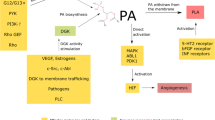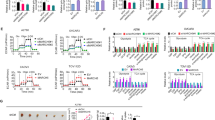Abstract
Platinum-based anticancer drugs, including cisplatin and carboplatin, have been cornerstones in the treatment of solid tumors. We report here that these DNA-damaging agents, particularly cisplatin, induce apoptosis through plasma membrane disruption, triggering FAS death receptor via mitochondrial (intrinsic) pathways. Our objectives were to: quantify the composition of membrane metabolites; and determine the potential involvement of acid sphingomyelinase (ASMase) in the FAS-mediated apoptosis in ovarian cancer after cisplatin treatment. The resulting analysis revealed enhanced apoptosis as measured by: increased phosphocholine, and glycerophosphocholine; elevated cellular energetics; and phosphocreatine and nucleoside triphosphate concentrations. The plasma membrane alterations were accompanied by increased ASMase activity, leading to the upregulation of FAS, FASL and related pro-apoptotic BAX and PUMA genes. Moreover FAS, FASL, BAX, PUMA, CASPASE-3 and -9 proteins were upregulated. Our findings implicate ASMase activity and the intrinsic pathways in cisplatin-mediated membrane demise, and contribute to our understanding of the mechanisms by which ovarian tumors may become resistant to cisplatin.





Similar content being viewed by others
References
Greene MH, Clark JW, Blayney DW (1984) The epidemiology of ovarian cancer. Semin Oncol 11(3):209–226
Bose RN (2002) Biomolecular targets for platinum antitumor drugs. Mini Rev Med Chem 2(2):103–111
Kelland L (2007) The resurgence of platinum-based cancer chemotherapy. Nat Rev Cancer 7(8):573–584
Wang D, Lippard SJ (2005) Cellular processing of platinum anticancer drugs. Nat Rev Drug Discov 4(4):307–320
Boulikas T, Vougiouka M (2003) Cisplatin and platinum drugs at the molecular level. (Review). Oncol Rep 10(6):1663–1682
Demarcq C, Bunch RT, Creswell D, Eastman A (1994) The role of cell cycle progression in cisplatin-induced apoptosis in Chinese hamster ovary cells. Cell Growth Differ 5(9):983–993
Chu G (1994) Cellular responses to cisplatin. The roles of DNA-binding proteins and DNA repair. J Biol Chem 269(2):787–790
Henkels KM, Turchi JJ (1999) Cisplatin-induced apoptosis proceeds by caspase-3-dependent and -independent pathways in cisplatin-resistant and -sensitive human ovarian cancer cell lines. Cancer Res 59(13):3077–3083
Lee W, St Onge RP, Proctor M, Flaherty P, Jordan MI, Arkin AP, Davis RW, Nislow C, Giaever G (2005) Genome-wide requirements for resistance to functionally distinct DNA-damaging agents. PLoS Genet 1(2):e24
Taylor AE, Johnson DC, Kazemi H (1992) Environmental tobacco smoke and cardiovascular disease. A position paper from the Council on Cardiopulmonary and Critical Care, American Heart Association. Circulation 86(2):699–702
Brozovic A, Osmak M (2007) Activation of mitogen-activated protein kinases by cisplatin and their role in cisplatin-resistance. Cancer Lett 251(1):1–16
Huang CR, Jin ZX, Dong L, Tong XP, Yue S, Kawanami T, Sawaki T, Sakai T, Miki M, Iwao H et al (2010) Cisplatin augments FAS-mediated apoptosis through lipid rafts. Anticancer Res 30(6):2065–2071
Fulda S, Debatin KM (2006) Extrinsic versus intrinsic apoptosis pathways in anticancer chemotherapy. Oncogene 25(34):4798–4811
Fulda S, Meyer E, Friesen C, Susin SA, Kroemer G, Debatin KM (2001) Cell type specific involvement of death receptor and mitochondrial pathways in drug-induced apoptosis. Oncogene 20(9):1063–1075
Martin SJ, Green DR (1995) Protease activation during apoptosis: death by a thousand cuts? Cell 82(3):349–352
Gulbins E, Coggeshall KM, Brenner B, Schlottmann K, Linderkamp O, Lang F (1996) Fas-induced apoptosis is mediated by activation of a Ras and Rac protein-regulated signaling pathway. J Biol Chem 271(42):26389–26394
Schuchman EH (2010) Acid sphingomyelinase, cell membranes and human disease: lessons from Niemann-Pick disease. FEBS Lett 584(9):1895–1900
Gill BM, Nishikata H, Chan G, Delovitch TL, Ochi A (1994) Fas antigen and sphingomyelin-ceramide turnover-mediated signaling: role in life and death of T lymphocytes. Immunol Rev 142:113–125
Grassme H, Jekle A, Riehle A, Schwarz H, Berger J, Sandhoff K, Kolesnick R, Gulbins E (2001) CD95 signaling via ceramide-rich membrane rafts. J Biol Chem 276(23):20589–20596
Reynolds CP, Maurer BJ, Kolesnick RN (2004) Ceramide synthesis and metabolism as a target for cancer therapy. Cancer Lett 206(2):169–180
Grassme H, Cremesti A, Kolesnick R, Gulbins E (2003) Ceramide-mediated clustering is required for CD95-DISC formation. Oncogene 22(35):5457–5470
Bollinger CR, Teichgraber V, Gulbins E (2005) Ceramide-enriched membrane domains. Biochim Biophys Acta 1746(3):284–294
Lacour S, Hammann A, Grazide S, Lagadic-Gossmann D, Athias A, Sergent O, Laurent G, Gambert P, Solary E, Dimanche-Boitrel MT (2004) Cisplatin-induced CD95 redistribution into membrane lipid rafts of HT29 human colon cancer cells. Cancer Res 64(10):3593–3598
Rebillard A, Tekpli X, Meurette O, Sergent O, LeMoigne-Muller G, Vernhet L, Gorria M, Chevanne M, Christmann M, Kaina B et al (2007) Cisplatin-induced apoptosis involves membrane fluidification via inhibition of NHE1 in human colon cancer cells. Cancer Res 67(16):7865–7874
Moghaddas S, Majmudar P, Marin R, Dezvareh H, Qi C, Soans E, Bose RN (2012) Phosphaplatins, next generation platinum antitumor agents: a paradigm shift in designing and defining molecular targets. Inorg Chim Acta 393:173–181
Eva A, Robbins KC, Andersen PR, Srinivasan A, Tronick SR, Reddy EP, Ellmore NW, Galen AT, Lautenberger JA, Papas TS et al (1982) Cellular genes analogous to retroviral onc genes are transcribed in human tumour cells. Nature 295(5845):116–119
Johnson SW, Swiggard PA, Handel LM, Brennan JM, Godwin AK, Ozols RF, Hamilton TC (1994) Relationship between platinum-DNA adduct formation and removal and cisplatin cytotoxicity in cisplatin-sensitive and -resistant human ovarian cancer cells. Cancer Res 54(22):5911–5916
Olivero OA, Semino C, Kassim A, Lopez-Larraza DM, Poirier MC (1995) Preferential binding of cisplatin to mitochondrial DNA of Chinese hamster ovary cells. Mutat Res 346(4):221–230
Williams SN, Anthony ML, Brindle KM (1998) Induction of apoptosis in two mammalian cell lines results in increased levels of fructose-1,6-bisphosphate and CDP-choline as determined by 31P MRS. Magn Reson Med 40(3):411–420
Hakumaki JM, Kauppinen RA (2000) 1H NMR visible lipids in the life and death of cells. Trends Biochem Sci 25(8):357–362
May GL, Wright LC, Holmes KT, Williams PG, Smith IC, Wright PE, Fox RM, Mountford CE (1986) Assignment of methylene proton resonances in NMR spectra of embryonic and transformed cells to plasma membrane triglyceride. J Biol Chem 261(7):3048–3053
Rebillard A, Rioux-Leclercq N, Muller C, Bellaud P, Jouan F, Meurette O, Jouan E, Vernhet L, Le Quement C, Carpinteiro A et al (2008) Acid sphingomyelinase deficiency protects from cisplatin-induced gastrointestinal damage. Oncogene 27(51):6590–6595
Evanochko WT, Sakai TT, Ng TC, Krishna NR, Kim HD, Zeidler RB, Ghanta VK, Brockman RW, Schiffer LM, Braunschweiger PG et al (1984) NMR study of in vivo RIF-1 tumors. Analysis of perchloric acid extracts and identification of 1H, 31P and 13C resonances. Biochim Biophys Acta 805(1):104–116
Rotolo JA, Zhang J, Donepudi M, Lee H, Fuks Z, Kolesnick R (2005) Caspase-dependent and -independent activation of acid sphingomyelinase signaling. J Biol Chem 280(28):26425–26434
Garcia-Barros M, Paris F, Cordon-Cardo C, Lyden D, Rafii S, Haimovitz-Friedman A, Fuks Z, Kolesnick R (2003) Tumor response to radiotherapy regulated by endothelial cell apoptosis. Science 300(5622):1155–1159
Goni FM, Alonso A (2002) Sphingomyelinases: enzymology and membrane activity. FEBS Lett 531(1):38–46
Korsmeyer SJ (1999) BCL-2 gene family and the regulation of programmed cell death. Cancer Res 59(7 Suppl):1693s–1700s
Kaye S, Merry S (1985) Tumour cell resistance to anthracyclines–a review. Cancer Chemother Pharmacol 14(2):96–103
Surette ME, Winkler JD, Fonteh AN, Chilton FH (1996) Relationship between arachidonate–phospholipid remodeling and apoptosis. Biochemistry 35(28):9187–9196
Podo F (1999) Tumour phospholipid metabolism. NMR Biomed 12(7):413–439
Tome ME, Lutz NW, Briehl MM (2003) Overexpression of catalase or Bcl-2 delays or prevents alterations in phospholipid metabolism during glucocorticoid-induced apoptosis in WEHI7.2 cells. Biochim Biophys Acta 1642(3):149–162
Daly PF, Lyon RC, Faustino PJ, Cohen JS (1987) Phospholipid metabolism in cancer cells monitored by 31P NMR spectroscopy. J Biol Chem 262(31):14875–14878
Fallbrook A, Turenne SD, Mamalias N, Kish SJ, Ross BM (1999) Phosphatidylcholine and phosphatidylethanolamine metabolites may regulate brain phospholipid catabolism via inhibition of lysophospholipase activity. Brain Res 834(1–2):207–210
Richter C, Schweizer M, Cossarizza A, Franceschi C (1996) Control of apoptosis by the cellular ATP level. FEBS Lett 378(2):107–110
Li T, Wang N, Zhao M (2012) Neuroprotective effect of phosphocreatine on focal cerebral ischemia-reperfusion injury. J Biomed Biotechnol 2012:168756
Ullman MD, Radin NS (1974) The enzymatic formation of sphingomyelin from ceramide and lecithin in mouse liver. J Biol Chem 249(5):1506–1512
Marggraf WD, Anderer FA, Kanfer JN (1981) The formation of sphingomyelin from phosphatidylcholine in plasma membrane preparations from mouse fibroblasts. Biochim Biophys Acta 664(1):61–73
Marggraf WD, Zertani R, Anderer FA, Kanfer JN (1982) The role of endogenous phosphatidylcholine and ceramide in the biosynthesis of sphingomyelin in mouse fibroblasts. Biochim Biophys Acta 710(3):314–323
Takahashi I, Takahashi T, Mikami T, Komatsu M, Ohura T, Schuchman EH, Takada G (2005) Acid sphingomyelinase: relation of 93lysine residue on the ratio of intracellular to secreted enzyme activity. Tohoku J Exp Med 206(4):333–340
Levade T, Jaffrezou JP (1999) Signalling sphingomyelinases: which, where, how and why? Biochim Biophys Acta 1438(1):1–17
Zeidan YH, Jenkins RW, Hannun YA (2008) Remodeling of cellular cytoskeleton by the acid sphingomyelinase/ceramide pathway. J Cell Biol 181(2):335–350
Smart EJ, Graf GA, McNiven MA, Sessa WC, Engelman JA, Scherer PE, Okamoto T, Lisanti MP (1999) Caveolins, liquid-ordered domains, and signal transduction. Mol Cell Biol 19(11):7289–7304
Chatterjee S (1994) Neutral sphingomyelinase action stimulates signal transduction of tumor necrosis factor-alpha in the synthesis of cholesteryl esters in human fibroblasts. J Biol Chem 269(2):879–882
Ridgway ND, Lagace TA, Cook HW, Byers DM (1998) Differential effects of sphingomyelin hydrolysis and cholesterol transport on oxysterol-binding protein phosphorylation and Golgi localization. J Biol Chem 273(47):31621–31628
Tepper CG, Jayadev S, Liu B, Bielawska A, Wolff R, Yonehara S, Hannun YA, Seldin MF (1995) Role for ceramide as an endogenous mediator of Fas-induced cytotoxicity. Proc Natl Acad Sci USA 92(18):8443–8447
Estrov Z, Thall PF, Talpaz M, Estey EH, Kantarjian HM, Andreeff M, Harris D, Van Q, Walterscheid M, Kornblau SM (1998) Caspase 2 and caspase 3 protein levels as predictors of survival in acute myelogenous leukemia. Blood 92(9):3090–3097
Anderson NS, Turner L, Livingston S, Chen R, Nicosia SV, Kruk PA (2009) Bcl-2 expression is altered with ovarian tumor progression: an immunohistochemical evaluation. J Ovarian Res 2:16
Yee KS, Vousden KH (2008) Contribution of membrane localization to the apoptotic activity of PUMA. Apoptosis 13(1):87–95
Koch JM, Lay DC Jr, McMunn KA, Moritz JS, Wilson ME (2007) Motivation of hens to obtain feed during a molt induced by feed withdrawal, wheat middlings, or melengestrol acetate. Poult Sci 86(4):614–620
Deng J, Shimamura T, Perera S, Carlson NE, Cai D, Shapiro GI, Wong KK, Letai A (2007) Proapoptotic BH3-only BCL-2 family protein BIM connects death signaling from epidermal growth factor receptor inhibition to the mitochondrion. Cancer Res 67(24):11867–11875
Lacasse EC, Kandimalla ER, Winocour P, Sullivan T, Agrawal S, Gillard JW, Durkin J (2005) Application of XIAP antisense to cancer and other proliferative disorders: development of AEG35156/GEM640. Ann NY Acad Sci 1058:215–234
Campas C, Lopez JM, Santidrian AF, Barragan M, Bellosillo B, Colomer D, Gil J (2003) Acadesine activates AMPK and induces apoptosis in B-cell chronic lymphocytic leukemia cells but not in T lymphocytes. Blood 101(9):3674–3680
Zaccheo O, Dinsdale D, Meacock PA, Glynn P (2004) Neuropathy target esterase and its yeast homologue degrade phosphatidylcholine to glycerophosphocholine in living cells. J Biol Chem 279(23):24024–24033
Acknowledgments
Part of this work was performed at the Department of Chemistry and Biochemistry, Northern Illinois University, Faraday Hall, DeKalb, IL 60115, and the Department of Biomedical Sciences, Ohio University, Athens, OH 45701, USA. RNB gratefully acknowledges the partial support of this work by the Cancer Prevention Research Institute of Texas (Grant No. RP130553).
Author information
Authors and Affiliations
Corresponding authors
Rights and permissions
About this article
Cite this article
Maurmann, L., Belkacemi, L., Adams, N.R. et al. A novel cisplatin mediated apoptosis pathway is associated with acid sphingomyelinase and FAS proapoptotic protein activation in ovarian cancer. Apoptosis 20, 960–974 (2015). https://doi.org/10.1007/s10495-015-1124-2
Published:
Issue Date:
DOI: https://doi.org/10.1007/s10495-015-1124-2




